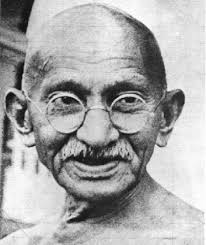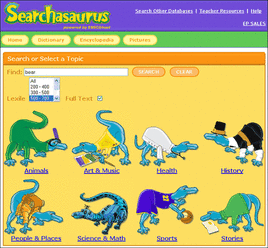
The holiday divinity and fudge are just about gone, and the heart-warming Christmas movies seem to have been replaced by weight-loss commercials. I’ve made more than my share of New Year’s resolutions, and rarely have I stuck to the calorie-counting, mile-running regimens that I have planned.
This year, rather than set some lofty goals that I will most likely fail to achieve, I plan to stop trying to find who or what is to blame for the problems with education today. Instead I want to purposefully do everything I can to effect positive changes for my students, get to know them better as individuals, and connect their learning to content that they find valuable and relevant to their own lives.I’ll adopt a mantra that will help me focus my energies ... at least my professional energies. This year I think my new rallying cry will be, “Be the change you want to see in the world: Teach.”
 I know this sounds mighty familiar. I did a little research about the original quote and discovered that Mahatma Gandhi didn’t actually say it, though he is often credited. The closest verifiable reference I found is more about how Gandhi believed that, by changing ourselves, we can also change the world. I think that makes the implied reference even more powerful. Gandhi’s vision was about transformation, and transformation must start at an individual level. That is what New Year’s resolutions are all about, right?
I know this sounds mighty familiar. I did a little research about the original quote and discovered that Mahatma Gandhi didn’t actually say it, though he is often credited. The closest verifiable reference I found is more about how Gandhi believed that, by changing ourselves, we can also change the world. I think that makes the implied reference even more powerful. Gandhi’s vision was about transformation, and transformation must start at an individual level. That is what New Year’s resolutions are all about, right?
Gandhi also taught that systemic change requires a large number of individuals working together with discipline and persistence. That is encouraging because so many educators I know live this slogan. If those of us who are vested participants are willing to do the work, stay the course, and insist on positive changes, then our children will receive the kind of education that they deserve and that our country needs.
IDENTIFYING STUDENT NEEDS
Although this commitment seems a bit too esoteric to really make a difference in the practical world of the classroom, I’m confident that I know at least some of what students need:
- Students need to learn to think critically
- Students need to learn how to find relevant information and evaluate sources
- Students need to communicate effectively in a wide variety of situations
- Students need to be able to work collaboratively
- Students need to develop strategies for problem solving—because the world doesn’t come with multiple-choice options
- Students need to be fluent in the use of educational technology
- Students need to be innovative in the development of their own ideas
I did some research on student success over the holiday break. I’m working on my master’s project, and the big question for me is how to help our students not only pass the test, but own their newly learned thinking strategies and generalize them to new challenges in their own learning and lives. Most educators are striving for sustained learning. I keep finding recurring themes in my research, including know your students and empower them to own their learning. We need to know where our students come from and what they care about if we are going to be able to truly engage their interests and their passions. They need to be able to see how what we are teaching is relevant and valuable to their lives. My goal for 2016 is to work harder to help them see that link.
MAKING REAL-WORLD CONNECTIONS
The first place I'm going to start is with my upcoming problem/solution unit. I've decided to have my students begin by brainstorming problems they see in their personal worlds. I want them to consider challenges at their immediate level: simple things like unorganized lockers or never having a pencil when you need one. From there we will all move out to local, national, and then global challenges. Once that is finished, my students will choose the one problem that they see as especially urgent, or perhaps fun to solve, and work together in small groups to design a solution. I’m hoping that I can structure this unit in a way that will help me begin to achieve my goals.
Let’s look a little more closely at this unit. My students will be personally engaged and empowered because they will be working to solve a real problem, one of their own problems. After choosing a focus, my students will need to identify the initiating event, the true root of their challenge. Are they always without a pencil because they don’t have enough pencils or because they always misplace them? This step is critical if they are going to truly solve a problem and not just treat the symptoms, and it requires critical thinking.
Next my problem solvers will be doing some research. Is this issue truly significant? Many times the biggest challenge here is what information would be the most helpful. Perhaps my students could investigate how the lack of basic materials affects student success. I just tried a quick Google search on “lack of supplies and student success” and ended up with mostly articles and data on how teachers often purchase needed supplies themselves. As that wouldn’t really serve my students’ purpose, I zeroed in on “lack of pencils student success.” These results were more on target.
 Working through that process is a great way to develop the problem-solving skills I identified, while utilizing educational technology in a meaningful way. We could also use some more controlled search tools. My state of Idaho provides access to EBSCOhost, which offers a variety of research sources ranging from Searchasauras to grade-level student research resources. Now we’re working on evaluating sources and validity.
Working through that process is a great way to develop the problem-solving skills I identified, while utilizing educational technology in a meaningful way. We could also use some more controlled search tools. My state of Idaho provides access to EBSCOhost, which offers a variety of research sources ranging from Searchasauras to grade-level student research resources. Now we’re working on evaluating sources and validity.
I group my students for this project by interest, so that everyone in the group has a vested interest in the problem they are working to solve. I make sure that each student has a separate, specific research task to complete so that they are all involved and accountable. In this example project, one student might be researching the effect of the lack of pencils on student success, one might be investigating possible resources for school supplies, and one might be researching technologies that don’t require pencils at all. This mutually responsible collaboration is a great way to learn the skills necessary for successful group work.
The final stages of my unit will have my students either identifying available solutions or creating their own, and then producing a short video commercial to “sell” their idea. They will be developing their own ideas and communicating them clearly to a defined audience. I think that covers all of my identified goals. Perhaps more importantly, though, I’m hoping that I will learn more about my students, and they will see the inherent value of methodically identifying, analyzing, and solving real-world problems.
A LASTING RESOLUTION
Clearly, systemic change is a long step from my personal mantra, but my borrowed slogan speaks hope to me. We can be the change. As teachers we are gifted and burdened with incredible responsibility. We have access to the minds and often the hearts of our nation’s most precious resource: our children. In them lies immeasurable potential. We could be teaching the woman who will cure diabetes, or the man who will find a new way to purify contaminated groundwater. Our history is rich with Horatio Alger stories of rebounding from difficulty and forging a way to success. We as educators can join in that tradition, because transformation has to begin with individuals.
Knowing more about my students as individuals, I can work to develop learning opportunities that will help them achieve great things. I know that many educators I work with are striving to accomplish this same goal. One of our strategic planning goals in our school is to develop projects that engage our students personally in their learning. We are working hard to better know our students and begin to “be the change.”
To me, that sounds a lot more motivating than losing those extra 10 pounds, only to gain them back all over again.
Do you have a New Year's resolution related to helping students connect and achieve in 2016? We’d love to hear from you! If you have an idea for a blog post, please click “Submit an Idea” at the top of this page. Or join the conversation in our Facebook community by clicking the button below.
Thank you for all that you do to make a difference in students' lives every day of every year!



